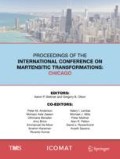Abstract
It is often observed that martensitic microstructures in adjacent polycrystal grains are related. For example, micrographs of Arlt (J Mat Sci 22:2655–2666, 1990) [1] (one reproduced in (Bhattacharya, Microstructure of martensite, 2003) [10, p 225]) exhibit propagation of layered structures across grain boundaries in the cubic-to-tetragonal phase transformation in \( {\text{BaTiO}}_{3} \). Such observations are related to requirements of compatibility of the deformation at the grain boundary. Using a generalization of the Hadamard jump condition, this is explored in the nonlinear elasticity model of martensitic transformations for the case of a bicrystal with suitably oriented columnar geometry, in which the microstructure in both grains is assumed to involve just two martensitic variants, with a planar or non-planar interface between the grains.
Access this chapter
Tax calculation will be finalised at checkout
Purchases are for personal use only
Notes
- 1.
The general form of the transformation stretch for an orthorhombic to monoclinic transformation is given in [8, Theorem 2.10(4)]. In general one can make a linear transformation of variables in the reference configuration which turns the corresponding energy wells into the form (1). However, in [4, Sect. 4.1] and the announcement of the results of the present paper in [5] it was incorrectly implied that the analysis based on K as in (1) applies to a general orthorhombic to monoclinic transformation. This is not the case because the linear transformation in the reference configuration changes the deformation gradient corresponding to austenite in [4] and to the rotated grain in the present paper. A more general, but feasible, analysis would be needed to cover the case of general orthorhombic to monoclinic transformations.
- 2.
For an explanation of gradient Young measures and how they can be used to represent possibly infinitely fine microstructures see, for example, [2].
- 3.
This extra condition, typically satisfied in practice, was accidentally omitted in the announcement in [5].
References
Arlt G (1990) Twinning in ferroelectric and ferroelastic ceramics: stress relief. J Mat Sci 22:2655–2666
Ball JM (2004) Mathematical models of martensitic microstructure. Mater Sci Eng A 78(1–2):61–69
Ball JM, Carstensen C Hadamard’s compatibility condition for microstructures (In preparation)
Ball JM, Carstensen C (1999) Compatibility conditions for microstructures and the austenite-martensite transition. Mater Sci Eng A 273–275:231–236
Ball JM, Carstensen C (2015) Geometry of polycrystals and microstructure. MATEC Web Conf 33:02007
Ball JM, James RD (1987) Fine phase mixtures as minimizers of energy. Arch Ration Mech Anal 100:13–52
Ball JM, James RD (1991) A characterization of plane strain. Proc Roy Soc London A 432:93–99
Ball JM, James RD (1992) Proposed experimental tests of a theory of fine microstructure, and the two-well problem. Phil Trans Roy Soc London A 338:389–450
Bhattacharya K (1992) Self-accommodation in martensite. Arch Ration Mech Anal 120:201–244
Bhattacharya K (2003) Microstructure of martensite, Oxford University Press
Bhattacharya K, Kohn RV (1997) Elastic energy minimization and the recoverable strain of polycrystalline shape-memory materials. Arch Ration Mech Anal 139:99–180
Khachaturyan AG (1983) Theory of structural transformations in solids, Wiley
Mardare S Personal communication
Acknowledgements
The research of JMB was supported by the EU (TMR contract FMRX - CT EU98-0229 and ERBSCI**CT000670), by EPSRC (GRlJ03466, EP/E035027/1, and EP/J014494/1), the ERC under the EU’s Seventh Framework Programme (FP7/2007–2013) / ERC grant agreement no 291053 and by a Royal Society Wolfson Research Merit Award.
Author information
Authors and Affiliations
Corresponding author
Editor information
Editors and Affiliations
Rights and permissions
Copyright information
© 2018 The Minerals, Metals & Materials Society
About this paper
Cite this paper
Ball, J.M., Carstensen, C. (2018). Interaction of Martensitic Microstructures in Adjacent Grains. In: Stebner, A., Olson, G. (eds) Proceedings of the International Conference on Martensitic Transformations: Chicago. The Minerals, Metals & Materials Series. Springer, Cham. https://doi.org/10.1007/978-3-319-76968-4_5
Download citation
DOI: https://doi.org/10.1007/978-3-319-76968-4_5
Published:
Publisher Name: Springer, Cham
Print ISBN: 978-3-319-76967-7
Online ISBN: 978-3-319-76968-4
eBook Packages: Chemistry and Materials ScienceChemistry and Material Science (R0)

